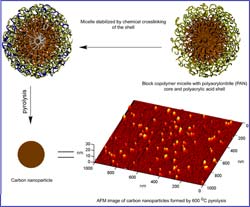Materials Sciences
Materials management deals with the research, development, manufacturing and processing of raw and industrial materials. Key aspects here are biological and medical issues, which play an increasingly important role in this field.
innovations-report offers in-depth articles related to the development and application of materials and the structure and properties of new materials.

Bizarre attractive force found in mayonnaise
Rice engineers find evidence of little-understood force in everyday emulsions
Scientists at Rice University have discovered that a little-understood tensile force, which was previously thought to be an oddity found only in the types of plastics used to make bulletproof vests, occurs in everyday emulsions like mayonnaise and salad dressing.
First identified about 25 years ago, the phenomenon known as “negative first normal stress difference” refers to an attractive force that

New family of hyperbranched polymers enhance mechanical, rheological, processing performance
Hyperbranched polymers – tree-like molecules – are not particularly useful for the creation of plastic films and molded parts because they don’t entangle. So Virginia Tech researchers have created segmented hyperbranched plastics, which do entangle and result in high-performance polymers.
Virginia Tech chemistry professor Timothy E. Long of Blacksburg will describe the configuration and functionality of the new family of polymers at the 227th Annual Meeting of the American Chemical Soc

Nanopowder Consisting Of Identical Particles
High-quality nanopowders made of refractory ceramics are a rare and very expensive material. All known methods of their manufacturing face the same problems – scanty quantities, extensive variety of particle sizes and expensive production. Researchers from the town of Tomsk have invented and manufactured a device to produce a choice selection of particles – all particles are equal to the required size and inexpensive. The project has been funded by two foundations – the Russian Foundation for Basic R

Composite fibers with carbon nanotubes offer improved mechanical & electrical properties
A new class of fibers
Strong and versatile carbon nanotubes are finding new applications in improving conventional polymer-based fibers and films. For example, composite fibers made from single-walled carbon nanotubes (SWNTs) and polyacrylonitrile – a carbon fiber precursor – are stronger, stiffer and shrink less than standard fibers.
Nanotube-reinforced composites could ultimately provide the foundation for a new class of strong and lightweight fibers with properties such a

Carnegie Mellon University creates novel carbon nanoparticles with vast potential
Innovative polymer chemistry employed
Carnegie Mellon University scientists have developed an attractive way to make discrete carbon nanoparticles for electrical components used in industry and research. This method, which employs polyacrylonitrile (PAN) as a nanoparticle precursor, is being presented by Chuanbing Tang, a Carnegie Mellon graduate student, on Sunday, March 28, at the 227th annual meeting of the American Chemical Society in Anaheim, Calif. (POLY69, Garden A). The resear

New technique uses household humidifier to create nanocomposite materials
In what may sound like a project from a high school science fair, scientists are using a household humidifier to create porous spheres a hundred times smaller than a red blood cell. The technique is a new and inexpensive way to do chemistry using sound waves, the researchers say.
In the home, ultrasonic humidifiers are used to raise humidity, reduce static electricity and ease discomfort from the common cold or cough. In the lab, chemists at the University of Illinois at Urbana-Champaign ar